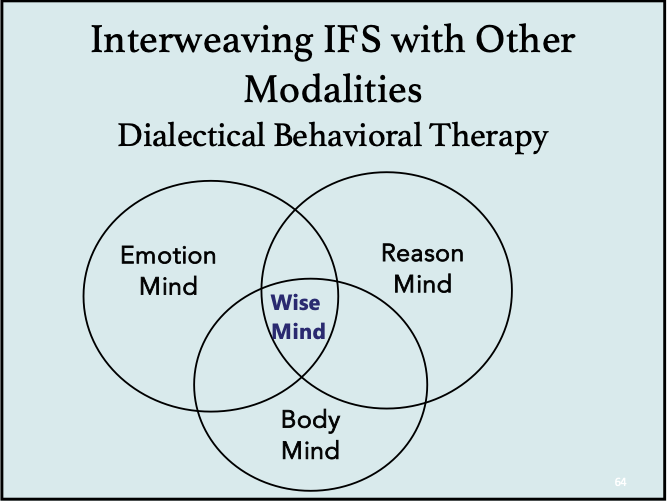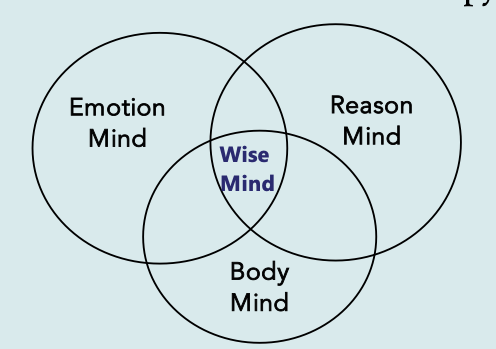Dialectical Behavior Therapy (DBT) and Internal Family Systems (IFS) are both therapeutic approaches that have gained recognition for their effectiveness in addressing various mental health challenges. While they have distinct origins and theoretical foundations, there are areas of intersection between DBT and IFS that can be explored.
DBT, developed by Marsha M. Linehan, is a cognitive-behavioral therapy that was initially designed to treat individuals with borderline personality disorder. DBT emphasizes skills training, emotional regulation, distress tolerance, mindfulness, and the therapeutic relationship. It aims to help individuals develop healthy coping mechanisms and navigate intense emotions and problematic behaviors.
IFS, developed by Richard Schwartz, is a model of therapy that focuses on the concept of "parts" within an individual's psyche. It suggests that individuals have various parts or subpersonalities, each with its own beliefs, emotions, and intentions. IFS aims to help individuals establish a compassionate relationship with these parts, facilitating healing and integration.
The intersection between DBT and IFS can be seen in the following areas:
1. Mindfulness: Both DBT and IFS emphasize the importance of mindfulness practices. Mindfulness is integrated into DBT to help individuals observe their experiences and cultivate nonjudgmental awareness. Similarly, IFS encourages individuals to develop a mindful and curious stance toward their parts, facilitating a deeper understanding of their internal landscape.
2. Emotion Regulation: DBT and IFS both address emotion regulation skills. DBT teaches individuals strategies to identify, understand, and manage intense emotions effectively. IFS recognizes that parts may hold specific emotions, and the therapy helps individuals develop self-compassion and empathy towards their parts' emotional experiences.
3. Trauma-informed approach: Both approaches recognize the impact of trauma on individuals' mental health. DBT and IFS incorporate trauma-informed principles and techniques to address trauma-related symptoms and promote healing.
4. Person-centered focus: While DBT and IFS have different frameworks, both approaches emphasize a person-centered and collaborative therapeutic relationship. Both therapies prioritize the individual's autonomy, respect their unique experiences, and work towards their goals.
5. Integration and wholeness: IFS focuses on facilitating integration and healing within an individual's internal system by fostering self-leadership and harmony among parts. DBT, on the other hand, aims to integrate different aspects of therapy, such as acceptance and change. Both approaches share the goal of helping individuals achieve a sense of wholeness and integration in their lives.
It's important to note that while there are areas of intersection between DBT and IFS, they are distinct therapeutic models with their own theories and techniques. The decision to integrate elements from both approaches should be made collaboratively with a trained therapist who is knowledgeable in both DBT and IFS, ensuring that the integration is tailored to the individual's specific needs and goals.
This worksheet by the UNC Chapel Hill School of Social Work discusses the intersection between IFS & DBT (near the end of the PDF):




DBT, developed by Marsha M. Linehan, is a cognitive-behavioral therapy that was initially designed to treat individuals with borderline personality disorder. DBT emphasizes skills training, emotional regulation, distress tolerance, mindfulness, and the therapeutic relationship. It aims to help individuals develop healthy coping mechanisms and navigate intense emotions and problematic behaviors.
IFS, developed by Richard Schwartz, is a model of therapy that focuses on the concept of "parts" within an individual's psyche. It suggests that individuals have various parts or subpersonalities, each with its own beliefs, emotions, and intentions. IFS aims to help individuals establish a compassionate relationship with these parts, facilitating healing and integration.
The intersection between DBT and IFS can be seen in the following areas:
1. Mindfulness: Both DBT and IFS emphasize the importance of mindfulness practices. Mindfulness is integrated into DBT to help individuals observe their experiences and cultivate nonjudgmental awareness. Similarly, IFS encourages individuals to develop a mindful and curious stance toward their parts, facilitating a deeper understanding of their internal landscape.
2. Emotion Regulation: DBT and IFS both address emotion regulation skills. DBT teaches individuals strategies to identify, understand, and manage intense emotions effectively. IFS recognizes that parts may hold specific emotions, and the therapy helps individuals develop self-compassion and empathy towards their parts' emotional experiences.
3. Trauma-informed approach: Both approaches recognize the impact of trauma on individuals' mental health. DBT and IFS incorporate trauma-informed principles and techniques to address trauma-related symptoms and promote healing.
4. Person-centered focus: While DBT and IFS have different frameworks, both approaches emphasize a person-centered and collaborative therapeutic relationship. Both therapies prioritize the individual's autonomy, respect their unique experiences, and work towards their goals.
5. Integration and wholeness: IFS focuses on facilitating integration and healing within an individual's internal system by fostering self-leadership and harmony among parts. DBT, on the other hand, aims to integrate different aspects of therapy, such as acceptance and change. Both approaches share the goal of helping individuals achieve a sense of wholeness and integration in their lives.
It's important to note that while there are areas of intersection between DBT and IFS, they are distinct therapeutic models with their own theories and techniques. The decision to integrate elements from both approaches should be made collaboratively with a trained therapist who is knowledgeable in both DBT and IFS, ensuring that the integration is tailored to the individual's specific needs and goals.
This worksheet by the UNC Chapel Hill School of Social Work discusses the intersection between IFS & DBT (near the end of the PDF):


